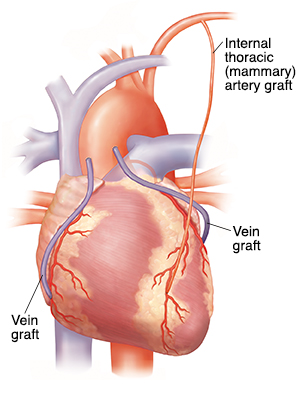Coronary Artery Bypass Surgery
Coronary Artery Bypass Surgery
Your coronary arteries are the vessels that carry blood to your heart muscle. If one or more of these arteries are blocked, blood can’t flow to the heart muscle. In this case, the heart muscle may die (heart attack) or become weakened and damaged and cause chest pain (angina). You may have shortness of breath, increasing tiredness (fatigue), leg swelling, or a run-down feeling. Coronary artery bypass surgery makes a path for blood to flow around a blockage. It helps reduce the risk for further damage to your heart caused by the lack of blood. It may also ease your symptoms of angina or shortness of breath.
Getting ready for surgery
Prepare for the procedure as you have been instructed. In addition:
Be sure to tell your healthcare provider about all medicines you take. This includes over-the-counter medicines. It also includes herbs and other supplements. You may need to stop taking some or all of them before surgery as directed by your healthcare provider.
Follow any directions you are given for not eating or drinking before surgery.
Preparing the bypass graft
First, a healthy blood vessel (graft) is taken from another part of your body. Taking this graft usually doesn't affect blood flow in that body part. Often more than one blockage occurs. If you have more than one blockage, you may need more than one graft. Sometimes the doctors will do special ultrasound tests to look at the possible grafts before surgery. One or more of these blood vessels will be used for the graft:
The saphenous vein, which is located in the leg.
The radial artery, which is located by the wrist.
The internal thoracic (mammary) arteries, which are located in the chest wall. There are two internal thoracic arteries, one on each side of the chest. Typically, the left one is used, but sometimes both are used.
Reaching the heart
While one member of the bypass team is harvesting the graft or grafts, another member works to reach your heart. The provider makes an incision in your chest. Then he or she opens the breastbone (sternum) down the middle and pulls it apart. The breastbone is held open throughout surgery. This puts pressure on the nerves of the chest. This is why you may have soreness and muscle spasms in your chest, shoulders, and back during recovery.
Attaching the graft
A small opening is made in the coronary artery, past the blockage:
If a saphenous vein or radial artery is used, one end of the graft is sewn onto this opening. The other end is typically sewn on to the aorta. Neither the diseased artery nor the blockage is removed. If a stent is present, it is not removed either. This is because the stent will already have become a permanent part of the artery.
If the internal thoracic (mammary) artery is used, one end of the graft is sewn onto this opening. The other end is already attached to a branch of the aorta.
Finishing up
Once the graft has been attached, blood will start flowing through this new pathway to bypass the blockage. If you have multiple blockages, more than one bypass may be done. Then your breastbone is rejoined with wires. These wires will stay in your chest permanently. They rarely cause a problem. They are safe around microwaves and airport metal detectors. The incision is closed, and you are taken to the intensive care unit to begin your recovery.
Using a heart-lung machine
Coronary artery bypass surgery can be done with the heart still beating (off pump) or with the heart still (on pump.) Your surgery team can tell you more about which type of surgery you will have:
On-pump surgery. A machine does the work of your heart and lungs during surgery. Blood is circulated through a heart-lung machine. The machine supplies the blood with oxygen and pumps it back through the body. In these cases, the heart may be stopped temporarily before the graft is attached. Your own heart and lungs start working again after the bypass is completed.
Off-pump surgery. The heart-lung machine is not used and the heart is not stopped. This is sometimes called a "beating heart" procedure.
There are advantages and disadvantages to each technique. If you have a question about why your doctor is using one technique instead of the other, don't be afraid to ask.
Risks and complications
You and your surgeon can discuss the risks and possible complications of coronary artery bypass surgery. They may include:
Excessive bleeding. You may need a blood transfusion or a trip back to the operating room.
Infection of the incision sites
Lung infection (pneumonia)
Fast or irregular heartbeat. This is almost always temporary.
Nerve injury or muscle spasms
Breathing problems
Memory problems or confusion
Heart attack, stroke, or death
Damage to other parts or organs of your body because of problems with blood circulation
Updated:
July 24, 2018
Sources:
2011 the American College of Cardiology Foundation/American Heart Association Guidelines for Coronary Artery Bypass Graft Surgery. Hillis DL. Journal of the American College of Cardiology. 2011;58(24):S123-S210., Completion Duplex Ultrasound Predicts Early Graft Thrombosis After Crural Bypass in Patients with Critical Limb Ischemia. Scalis S. Journal of Vascular Surgery. 2011;54(4):1006-10.
Reviewed By:
Fetterman, Anne, RN, BSN,Image reviewed by StayWell medical illustration team.,Mancini, Mary, MD
